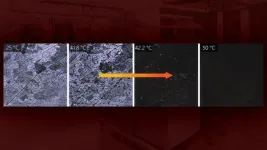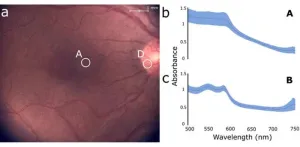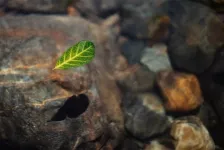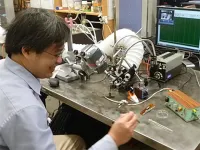(Press-News.org) SAN FRANCISCO – As efforts to transition away from fossil fuels strengthen the hunt for new sources of low-carbon energy, scientists have developed a deep learning model to scan the Earth for surface expressions of subsurface reservoirs of naturally occurring free hydrogen.
Researchers used the algorithm to help narrow down the potential whereabouts of ovoids or semicircular depressions (SCDs) in the ground that form near areas associated with natural or “gold hydrogen” deposits. Though these circular patterns often appear in areas of low elevation, they can be hidden by agriculture or other vegetation. Recent discoveries of these circles in the U.S., Mali, Namibia, Brazil, France and Russia have unveiled that they exist in greater numbers than previously thought.
To help uncover these nearly invisible semicircular depressions, two recent papers describe how lead authors Sam Herreid and Saurabh Kaushik, both postdoctoral scholars at the Byrd Polar and Climate Research Center at The Ohio State University, combined their model with global satellite imagery data to identify SCDs.
Their team compiled a list of known SCD locations to train their algorithm to search the globe. After using remote sensing data to analyze what these sites look like from above, they drew on geomorphic and spectral patterns to determine what sites around the world are most likely to be associated with SCDs related to geologic hydrogen.
Through their observations, the project found that AI demonstrates a unique ability to map out surface expressions of potential subsurface hydrogen reservoirs around the world, as well as establish a baseline for further investigation of hydrogen-associated sites. Their work was presented this week at poster sessions at the annual meeting of the American Geophysical Union.
Scientists have long been aware of hydrogen’s potential as one of nature’s cleanest and most efficient energy sources. Now, as governments invest in cleaner alternatives, interest in natural hydrogen is rapidly surging, said Joachim Moortgat, the project’s principal investigator and an associate professor of earth sciences at Ohio State.
“Hydrogen in general is a very attractive energy source,” Moortgat said. “If you burn it, its only by-product is water, and unlike wind or solar energy, hydrogen can be stored and transported, so there are all kinds of industries trying hard to make the switch.”
Since gold hydrogen is also produced continuously within Earth’s crust, some believe that access to a low-carbon energy resource that is nearly devoid of greenhouse gas emissions could reshape the global energy landscape. Yet researchers have found that locating hydrogen requires the development of new exploration tools, said Moortgat.
“One reason they’re difficult to find is that they probably occur in different kinds of geologies and locations than where you would find oil or gas,” he said. “But with the AI tools we develop, we map everything that could potentially be an SCD.”
Unfortunately, while researchers can use satellite data to narrow down areas of interest, real hydrogen deposits can easily be confused for other circular-looking land features, such as lakes, golf courses or crop circles.
And as countries scramble to expedite the search for hydrogen sources, many of them are already developing new ways to access this promising new energy, said Herreid.
“This work feels like it’s contributing in a proactive sense to mitigating the climate crisis,” said Herreid, a glaciologist who previously used AI to assist with modeling the impact of climate change on glaciers. “It’s very exciting to be involved in a project that’s really rapidly evolving.”
Abroad, Europe is already working on ways to take advantage of their stores of gold hydrogen, and at home in the U.S., laws like the Inflation Reduction Act are including provisions to expand the clean energy production industry.
Despite how fast-moving the field currently seems to be, it’ll take at least a few more years before natural hydrogen reservoirs are successfully integrated as a reliable source of clean energy. To that end, what researchers should focus on now is how they should go about deepening our understanding of these hydrogen systems, said Moortgat.
“The biggest challenge is that we need to find more SCDs and then really investigate how these things form,” he said. “Once we discover a lot more, we will be in a better position to again use AI tools to find similar ones worldwide.”
Ian M. Howat of Ohio State was also a co-author.
#
Contact: Joachim Moortgat, Moortgat.1@osu.edu
Written by: Tatyana Woodall, Woodall.52@osu.edu
END
Using AI to pinpoint hidden sources of clean energy underground
New method to scan the Earth for hydrogen deposits
2023-12-15
ELSE PRESS RELEASES FROM THIS DATE:
A study from IMDEA Software researchers reveals hidden fortunes and surprising overestimations in cybercrime revenue
2023-12-15
To what extent methodological limitations and incomplete data impact the revenue estimations of cybercriminal groups using the Bitcoin blockchain was largely unknown. A new study, conducted by IMDEA Software Institute researchers Gibran Gomez, Kevin van Liebergen, and Juan Caballero challenges existing figures regarding cybercriminals' Bitcoin earnings to date. The study, entitled "Cybercrime Bitcoin Revenue Estimations: Quantifying the Impact of Methodology and Coverage", recently presented at the ...
Department of Defense grant boosts study of pressure, humidity on thermal energy storage
2023-12-15
Under the Defense University Research Instrumentation Program, Dr. Patrick Shamberger and a research team from the Department of Materials Science and Engineering received a grant from the U.S. Department of Defense (DOD) to acquire instrumentation for thermal energy storage research.
The grant, administered through the Office of Naval Research, will support the acquisition of a high-sensitivity multi-modal calorimeter for advanced research and education on tunable energy storage materials. This equipment will allow cutting-edge research to study the capability of pressure and humidity to control how well these materials can store ...
IU researchers fill the final gaps in the Arabidopsis genome sequence and gain insights into gene regulatory mechanisms relevant to humans
2023-12-15
Arabidopsis thaliana is a species grown worldwide for genetic research and was the first plant to have its complete set of chromosomes (its genome) sequenced. The initial genome sequence, released in the year 2000, had numerous gaps, but technological improvements in the years since closed the gaps, one by one, until only two remained: large undefined regions on chromosomes 2 and 4 where genes encoding ribosomal RNAs are repeated in hundreds of copies. These ribosomal RNA gene clusters, known as nucleolus organizer regions (NORs), are not just difficult to define in Arabidopsis; gaps remain at ...
Toward more precise and flexible targeted spectroscopy measurements in the retina
2023-12-15
Many ocular diseases involve changes in the structure and function of different regions of the back of the eye, also known as the “eye fundus.” For example, fluorescent pigments and tiny yellowish deposits called drusen accumulate under the retina in age-related macular degeneration, and the degeneration of neurons called ganglion cells is a defining characteristic of glaucoma. Interestingly, changes in the eye fundus are not restricted to vision-related diseases only. Certain neurological diseases like Parkinson’s and Alzheimer’s can cause changes in retinal nerves and ...
UVA biomedical engineer unveils the dynamics of maternal immune responses
2023-12-15
Sepideh Dolatshahi, an assistant professor of biomedical engineering at the University of Virginia, is spearheading an exploration of systems immunology in its crucial development phase — during pregnancy.
Systems immunology is about unraveling concealed patterns within the human immune system, said Dolatshahi, whose approaches to her research span computational modeling, systems serology and cutting-edge spatial analysis techniques to investigate immune interactions between mother and fetus during pregnancy that could later support early childhood immunity.
Designing Tailored and Effective Vaccine Plans
Babies are immunocompromised ...
Novel therapeutic target overcomes resistance to radiation therapy
2023-12-15
A new study finds that radiation therapy (RT) suppresses a key protein called bone morphogenetic protein and activin membrane-bound inhibitor (BAMBI) and activates immune suppressive cells. These effects dampen the capacity of cancer-fighting immune cells and decrease the effectiveness of radiation, inducing therapy resistance in cancer patients, according to a paper published December 15, 2023 in the Journal of Clinical Investigation.
Radiation therapy is a common cancer treatment that kills cancer cells and activates immune cells to fight cancer. Yet this process also ...
Understanding atmospheric flash droughts in the Caribbean
2023-12-15
The word “drought” typically conjures images of parched soil, dust-swept prairies, depleted reservoirs, and dry creek beds, all the result of weeks or seasons of persistently dry atmospheric conditions.
In the sun-soaked islands in the Caribbean, however, drought conditions can occur much more rapidly, with warning signs appearing too late for mediation strategies to limit agriculture losses or prevent stresses on infrastructure systems that provide clean water to communities.
Such occurrences – known as flash droughts – are the focus of a new paper authored by Assistant Professor Craig Ramseyer of the College of Natural Resources ...
Pesticides and adjuvants disrupt honey bee’s sense of smell
2023-12-15
It has long been known that exposure to pesticide sprays is harmful to honey bees. In a new study, researchers have uncovered the effect of such sprays on the sense of smell in bees, which could disrupt their social signals.
Honey bees live in dynamic communities and constantly communicate with each other using chemicals that serve as social cues. For example, nurse bees—that are responsible for taking care of larvae that ultimately become queens and worker bees—constantly monitor the ...
Immune cells shape lung before birth and provide new avenues for treating respiratory diseases
2023-12-15
Immune cells play an active and intimate role in directing the growth of human lung tissue during development, researchers find, revolutionising our understanding of early lung development and the role of immune cells outside of immunity.
The research offers new insights for understanding and treating respiratory conditions, such as chronic obstructive pulmonary disease (COPD). Respiratory conditions account for almost 20 per cent of all deaths in children under five years worldwide1.
The work reveals a surprising coordination between the immune and respiratory systems, much earlier in development than previously thought. This discovery raises questions about the ...
Rembrandt broke new ground with lead-based impregnation of canvas for The Night Watch
2023-12-15
New research has revealed that Rembrandt impregnated the canvas for his famous 1642 militia painting ‘The Night Watch’ with a lead-containing substance even before applying the first ground layer. Such lead-based impregnation has never before been observed with Rembrandt or his contemporaries. The discovery, published today in Science Advances, underlines Rembrandt's inventive way of working, in which he did not shy away from using new techniques.
The surprising observation is yet another result from Operation Night Watch, the largest and most wide-ranging research and conservation project in the history ...
LAST 30 PRESS RELEASES:
School meals could unlock major gains for human and planetary health
Menopause hormone therapy does not appear to impact dementia risk
Signature patterns of brain activity may help predict recovery from traumatic brain injury
Dresden study uncovers new key mechanism in cancer cells
New species are now being discovered faster than ever before, study suggests
Cannabis-based products show limited short-term benefit for chronic pain, with increased risk of adverse effects
Cannabis products with more THC slightly reduce pain but cause more side effects
Clearing the brain of aging cells could aid epilepsy and reduce seizures
Brain injuries linked with potential risk of suicide, new study finds
New technique lights up where drugs go in the body, cell by cell
New study finds movement of fishing fleets can reveal shifts in marine ecosystems
Embargoed: New evidence points to potential treatment for vascular dementia
Study uncovers disrupted brain balance in alcohol dependence
Working in groups can help Republicans and Democrats agree on controversial content moderation online
Structural findings reveal how distinct GPCR ligands create different levels of activation
Anything-goes “anyons” may be at the root of surprising quantum experiments
UC review: Maximizing workplace opportunity for veterans
From generation to complex control: Metasurfaces make perfect vortex beams "within reach"
Thin-film lithium niobate-based detector: recent advances and perspectives
Exploring why some people may tend to persistently make bad choices
How cells balance their protein levels
Nirsevimab vs RSVpreF vaccine for RSV–related hospitalization in newborns
Effectiveness and impact of maternal RSV immunization and nirsevimab on medically attended RSV in US children
AI gives scientists a boost, but at the cost of too many mediocre papers
Next-generation vision model maps tree growth at sub-meter precision
Genes aren’t destiny for inherited blindness, study shows
MIT study: High-fat diets make liver cells more likely to become cancerous
Exposure to multiple fine particulate matter components and incident depression in the US Medicare population
Risk of burdensome health care spending over time in the US
Nirsevimab against hospitalizations and emergency department visits for lower respiratory tract infection in infants
[Press-News.org] Using AI to pinpoint hidden sources of clean energy undergroundNew method to scan the Earth for hydrogen deposits





